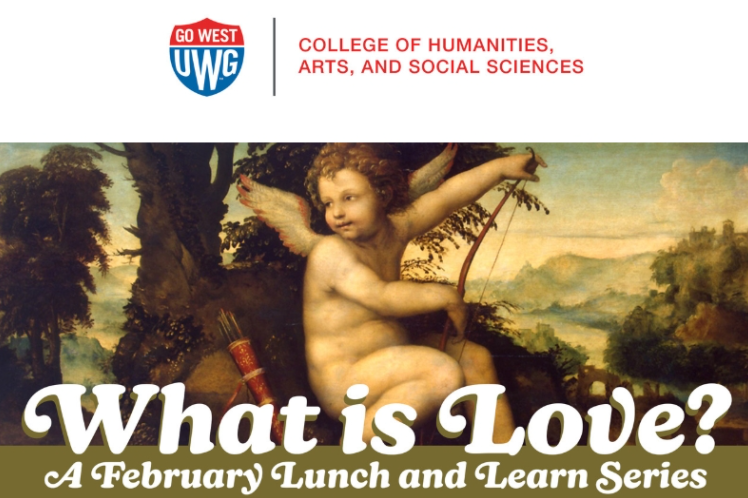Abbie Klein
The University of West Georgia’s College of Arts and Humanities is celebrating Valentine’s Day all month with lectures centered on love through the February Lunch and Learn Series. UWG’s own Dr. Laura Miller kicked off the series with her lecture on love story depictions in both film and literature. The lecture took place on Feb. 12 in the Humanities building with pizza and drinks available for the students and staff who attended.
Dr. Miller’s lecture focused on answering the question, “What makes a good love story?” She discussed what works well for these stories and what doesn’t. Depictions of romance in entertainment have always been such a crucial part of our society but there’s a certain satisfaction in emotional connection that is lacking in more modern love stories. “I think it’s one of the things that cross pollinates our culture and is something where most of the people I’ve spoken to about contemporary love stories have felt that some things are missed,” said Miller.
A lot of current love stories are now focused more on sex and sexual attraction rather than a more innocent and intimate connection that leaves people with a sense of belonging.
“You can still be a very sex positive person and still see a problem with this,” said Miller. “Sexuality and attraction are not identical to the process of falling in love.”
When identifying what makes a good love story, Miller broke it down into 10 elements of good love stories: play, falling, language, creation, seeing, blooming, mutuality, longing, time and sacrifice. These elements make the best and most lasting love stories.
“One classic example of this is the film Casablanca,” said Miller. “Where we see the love story between Rick and Ilsa kind of in flashbacks but it’s almost foreordained that Rick has to let her go.”
Other examples that Miller offered were novels like Tomorrow, and Tomorrow, and Tomorrow by Gabrielle Zevin and Louisa May Alcott’s Little Women. Along with films like An Affair to Remember and Roman Holiday, but one film she really focused on was James Cameron’s Titanic.
“If you look at these 10 concepts they’re all right in there and they’re all identified and sketched out really efficiently,” said Miller.
While these elements are great in establishing an emotional connection between characters the structure of these stories is just as important as the elements used and can really elevate it into being a timeless love story.
Miller explained this specific structural rhythm as a cycle consisting of falling in love, bonding, parting and reconnecting. This specific structure can begin at any part and repeat as many times as necessary and this is where variation in love stories comes from.
Miller praised the great romance novelist Jane Austen for her ability to utilize this cycle to create love stories that are not only realistic, but very human.
“Austen is brilliant at manipulating the timing of her love stories and often exaggerates one or more of these components beyond what many writers would feel comfortable doing,” said Miller.
Miller used both Pride and Prejudice and Persuasion as examples of how this structure can be used in two different ways but still effectively.
“In Pride and Prejudice Lizzy doesn’t realize she loves Darcy until really late in the book,” said Miller. “And in Persuasion so much of the love story has happened before we even get there.”
“And the ultimate reconnection where [Anne] finally learns how [Wentworth] feels about her is about five pages from the end of the book,” continued Miller.
The combination of the 10 elements used in this specific structure is what has made these stories so timeless and classic. Love does not change over time and authors like Jane Austen are a testament to that.
“I think it’s important to recognize what is missing when stories miss the mark and how to articulate what we want from entertainment,” said Miller. “Giving people something that is emotionally satisfying to them and not just pretty people and their problems I think is something that’s really missing.”
The College of Arts and Humanities will be continuing these lectures on Feb. 19 with Dr. Kathy Skott-Myhre. Dr. Skott-Myhre will be speaking about revolutionary love in terms of love becoming a biopolitcial event. Then on Feb. 24, Dr. Nathan Rees will be diving into how polygamy was featured in nineteenth century art through both critique and admiration.
You may also like
-
UWG’s Ingram Library Hosts Pop-Up Study Spot to Help Students Prepare for Finals Week
-
UWG Offers Mental Health Support And Academic Services To Maintain Student Success During Finals Week
-
UWG Alumnus Shares His Experience Exploring the Underground Flood Channels of Las Vegas
-
Georgia Students Simulate the Struggles of Dementia
-
UWG PR Students Score a Georgia Power Tour at Atlanta Corporate Office
